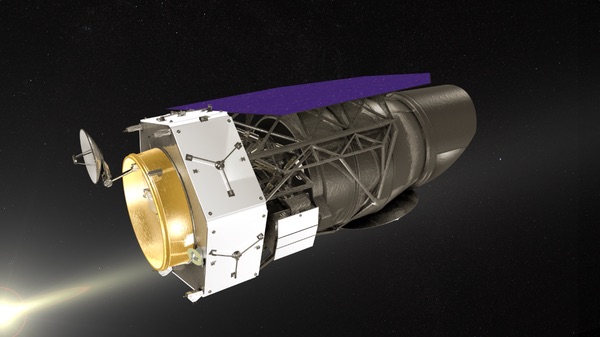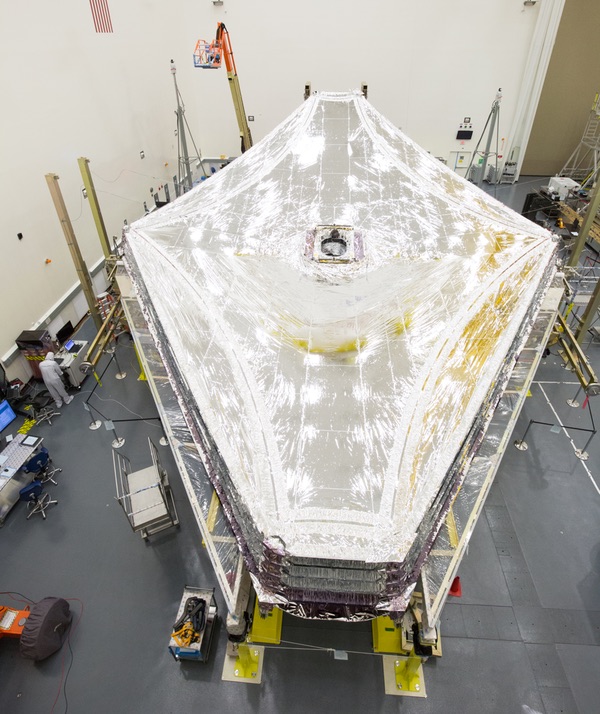More problems for big space telescopesby Jeff Foust
|
| “We have budget reserve at headquarters, so what we can use that money to do is essentially buy more time, and that’s what we’ve done,” Smith said. |
“The change in launch timing is not indicative of hardware or technical performance concerns,” Thomas Zurbuchen, associate administrator for NASA’s science mission directorate, said in a statement about the slip. “Rather, the integration of the various spacecraft elements is taking longer than expected.”
NASA cited in particular issues with the spacecraft bus and its sunshield, designed to keep the telescope and its instruments at the cryogenic temperatures required for their infrared observations.
“Webb’s spacecraft and sunshield are larger and more complex than most spacecraft,” said Eric Smith, the program director for JWST at NASA headquarters, in that statement. “The combination of some integration activities taking longer than initially planned, such as the installation of more than 100 sunshield membrane release devices, factoring in lessons learned from earlier testing, like longer time spans for vibration testing, has meant the integration and testing process is just taking longer.”
Smith and others faced questions at recent hearings by committees that advise NASA and the National Academies’ Space Studies Board on astrophysics issues. Among them was confusion by some astronomers how JWST, which previously had three and a half months of schedule margin, could slip its schedule by six months without affecting other programs, as NASA claimed.
Smith explained at a meeting of the Astrophysics Advisory Committee October 18 that the delay was funded by program reserves held at the headquarters level, separate from the project’s own reserves. “This delay is entirely funded by money in headquarters reserve,” he said.
He declined to disclose the size of that reserve. “We have budget reserve at headquarters, so what we can use that money to do is essentially buy more time, and that’s what we’ve done,” he said. That reserve, he added, would be largely expended on this delay.
In recent months, there was another issue that threatened to delay the launch. ESA’s BepiColombo mission to Mercury was, after its own series of delays, being prepared for a launch on an Ariane 5 at the same time as JWST: October 2018. Both missions couldn’t launch in the same month, and in fact, due to payload processing requirements, one would have to be prepared and launched before the other could begin processing at the French Guiana launch site. If BepiColombo won priority over JWST, it meant delaying JWST until early 2019 at the earliest.
However, Smith said that BepiColombo had no role in the delay. “In the end, it turned out to be completely unrelated,” he said. NASA owed ESA, which in turn owed launch provider Arianespace, one year’s notice for JWST’s launch. By late September, though, it was clear the telescope would not be ready for a fall 2018 launch. “It didn’t matter that Bepi was there. We needed to move for our own purposes.”
| “Fundamentally, approximately a year from launch it seems you discovered you needed another six months,” Young said. “That doesn’t say much for how well the program was being managed.” |
Smith said that there’s no specific launch readiness date yet for JWST beyond the March-June window, in part as NASA and prime contractor Northrop Grumman work on the sunshade and spacecraft bus issues, including a separate problem with thruster valves that need to be replaced.
At an October 24 meeting of the Space Studies Board’s Committee on Astronomy and Astrophysics, Smith gave a similar overview of the status of JWST, but faced sharper criticism from one committee member, Thomas Young, a former aerospace executive and NASA center director known for often blunt assessments.
“Fundamentally, approximately a year from launch it seems you discovered you needed another six months,” Young said. “That doesn’t say much for how well the program was being managed.”
Smith said schedule estimates for activities in this phase of assembly and testing of JWST “were found to be pretty optimistic.” He suggested there were issues at Northrop Grumman. “The person who was the integration and test lead at Northrop has new work now,” he said.
Young persisted in his questioning, arguing that NASA should have had more oversight into this to catch the delays sooner. Smith agreed. “We should have been more conservative from the start on this schedule,” he said.
“Realistic, maybe,” Young interjected.
The updated schedule, Smith, said has “more realism” into its estimates. “This is much harder than I would have expected.”
 Illustration of the planned WFIRST spacecraft, which will undergo a review in order to cut costs, at the expense of some science. (credit: NASA) |
Long before JWST’s latest problems, NASA was already working to apply the lessons learned from it on its next large astrophysics mission, the Wide Field Infrared Survey Telescope, or WFIRST. While WFIRST won’t be as large as JWST—its primary mirror, one of two donated to NASA by the National Reconnaissance Office five years ago, is 2.4 meters across—it will be NASA’s largest astrophysics mission since JWST with a budget in the billions of dollars.
After a National Academies committee, reviewing progress on the implementation of the latest astrophysics decadal survey, warned last year that budget growth in WFIRST could threaten NASA’s overall balance of programs, the agency established an independent review team for the mission before allowing it to pass a milestone known as Key Decision Point B.
| “The bottom line is that the current scope and complexity don’t fit with the anticipated available funds,” said Michelson. |
That report by the WFIRST Independent External Technical/Management/Cost Review (WIETR), delivered to NASA earlier this month, has yet to be released by the agency, but was critical enough that it warranted changes to the program. In an October 19 letter, Zurbuchen directed NASA’s Goddard Space Flight Center, where WFIRST is based, to redesign elements of the mission to lower its cost.
“The WFIRST project’s latest life cycle cost estimate for the mission of $3.6B (as compared to the earlier [estimate] of $3.2B) was validated by the independent review team,” he wrote. “I am directing the Goddard Space Flight Center to study modifying the current WFIRST design, the design that was reviewed by the WIETR, to reduce cost and complexity sufficient to have a cost estimate consistent with the $3.2B cost target set at the beginning of Phase A.”
Those cuts would come from unspecified “reductions” in a wide-field camera that is one of the mission’s primary instruments, as well as a separate coronagraph instrument that would also be treated as a “technology demonstration” because of the risks posed by its advanced technology.
Other elements of WFIRST, including its use of the NRO-donated mirror, would be unaffected by the change, for now. However, Zurbuchen warned that if this effort, to be completed by early next year, could not meet the new cost target, “I will direct a follow-on study of a WFIRST mission consistent with the architecture described by the Decadal Survey.” That original architecture called for the use of a much smaller mirror, 1.5 meters across or smaller.
NASA has yet to release the report, but the co-chairs of the WIETR panel briefed the Committee on Astronomy and Astrophysics about their study October 25. “The bottom line is that the current scope and complexity don’t fit with the anticipated available funds,” said Peter Michelson, one of the co-chairs.
That briefing revealed that the $3.6 billion cost estimate for WFIRST currently is at the 50-percent confidence level; that is, there is only a 50-percent chance that the mission would cost no more than that. Moving to the 70-percent confidence level, typically used for NASA missions once in a later phase of development, increased the cost estimate to more than $3.9 billion.
Some committee members dismissed the lower cost estimate. “A 50-percent confidence, in NASA’s experience, is not an executable program,” said Tom Young. “The most probable outcome is the 70-percent number.” Orlando Figueroa, the other WIETR co-chair, agreed, calling the 50-percent number “not adequate.”
Further complicating the cost estimate is a desire to address the level of risk for the mission. The report noted that NASA considered WFIRST a “Class B” mission in its categorization of risk, making it not nearly as rigorous than Class A missions, to which large missions like WFIRST are typically assigned. The review found that moving WFIRST to the Class A category could cost an additional $300 million or so.
“So you’re really recommending, if the requirements stay as they are, you’re saying this should be budgeted at $4.2 billion,” Young said.
NASA’s direction to the mission team, however, is to bring the cost down to $3.2 billion at that 50-percent level, while also increasing the risk posture of WFIRST to be “compatible” with a Class A mission. That will require some sacrifices, the agency acknowledges.
“You can’t do this without losing some science,” said Paul Hertz, director of NASA’s astrophysics division. “So the WFIRST that the team brings forward in the February timeframe is going to incorporate science reductions from the one baselined now.” That will still be well above the recommendations of the decadal survey, he added. “It continues to make this a mission which is deserving of our implementation as a strategic mission in the astrophysics program.”
| “You can’t do this without losing some science,” said Hertz. “So the WFIRST that the team brings forward in the February timeframe is going to incorporate science reductions from the one baselined now.” |
He also defended a decision not to release the WIETR report immediately. “The WIETR report has a lot of details in it, a lot of options that the panel laid out as possibilities for the team,” he said. “We want to give the project some space to make choices and come forward with a modified design without being second-guessed all the time in public.” Zurbuchen said that the report will be released next February, when the revised spacecraft design is due.
Despite the concerns about potential increasing costs, there are signs that NASA is applying the lessons learned from JWST on WFIRST. The concerns about costs and immature technologies—including not just the coronagraph but proposals to make the observatory compatible with a future starshade—are being addressed early in the mission, while still in Phase A, and not later, when problems would be more difficult, expensive, and time-consuming to address.
The WIETR co-chairs, at the committee meeting, praised the project for the progress it has made. “There has been a significant investment to date on this mission, on the order of $300 million,” said Figueroa. “It is very mature for where they are in Phase A.” It has, though, a long way to go.
